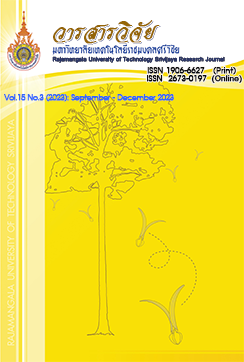Effect of The Particle Size of Polypropylene with Flakes Shape on Rotational Molding
Keywords:
particle size, polypropylene, flake shape, rotational molding, waste plastics glassesAbstract
This research aims to study the effect of polypropylene particle size with flake shape on the rotational molding process. The polypropylene used in the experiment was obtained from waste plastic glass with transparent single-use packaging. The procedure of research started with the waste plastic glass crushing and sieving into small (rPP-S), medium (rPP-M), and large (rPP-L) sizes, then the characteristics of particles were analyzed. The specimens were molded with the axial powder flow apparatus at a rotation speed of 7 rpm, using a molding temperature of 210 °C. The phenomena that occurred during the molding were observed and recorded. After that, the tests of the physical, thermal, and mechanical properties were carried out. The results showed that small particle size directly affected the rotational molding both in the solid state which is involved in particle motion and the heat transfer of the particles and in a liquid state which involved the bubbles in the specimens. Comparing the potential of processibility, it was found that the case of rPP-S had higher potential and compressive strength than rPP-M and rPP-L about 21.77% and 30.49% respectively.
References
Bellehumeur, C.T., Bisaria, M.K. and Vlachopoulos, J. 1996. An experimental study and model assessment of polymer sintering. Polymer Engineering & Science 36(17): 2198-2207.
Crawford, R.J. and Throne, J.L. 2001. Rotational molding technology. William Andrew, New York.
Cumberland, D.J. and Crawford, R.J. 1987. The packing of particles. Elsevier, New York.
Geldart, D., Abdullah, E.C., Hassanpour, A., Nwoke, L.C. and Wouters, I.J.C.P. 2006. Characterization of powder flowability using measurement of angle of repose. China Particuology 4(3-4): 104-107.
Greco, A. and Maffezzoli, A. 2004. Powder-shape analysis and sintering behavior of high-density polyethylene powders for rotational molding. Journal of applied polymer science 92(1): 449-460.
Guillén-Castellanos, S.A., Lin, W., Bellehumeur, C.T. and Weber, M. 2003. Effect of processing history on the intering of ethylene copolymers. International Polymer Processing 18(1): 87-90.
Jansri, E. and Narongchai, O. 2018. Polypropylene/ Polyethylene two-layered by one-step rotational molding. Journal of Polymer Engineering 38(7): 685-694.
Perot, E., Lamnawar, K. and Maazouz, A. 2008. Optimization and modelling of rotational molding process. International Journal of Material Forming 1(1): 783-786.
Pick, L.T. and Harkin-Jones, E. 2003. An investigation into the relationship between the impact performance of rotationally molded polyethylene products and their dynamic mechanical properties. Polymer Engineering & Science 43(4): 905-918.
Pop-Iliev, R., Liu, F.Y., Liu, G.B. and Park, C.B. 2003. Rotational foam molding of polypropylene with control of melt strength. Advances in Polymer Technology 22(4): 280-296.
Rao, M.A. and Throne, J.L. 1972. Principles of rotational molding. Polymer Engineering & Science 12(4): 237 264.
Rosato, D.V., Schott, N.R. and Rosato, M.G. 2001. Plastics Institute of America Plastics Engineering, Manufacturing & Data Handbook. Springer Science & Business Media, New York.
Sharma, T., Mahanwar, P. and Bambole, V. 2009. Study of modified polypropylene for rotational moulding applications. International Journal of Plastics Technology 13(1): 83-94.
Shenoy, A.V. 2013. Rheology of filled polymer systems. Springer Science & Business Media, Berlin.
Spence, A.G. and Crawford, R.J. 1996. Removal of pinholes and bubbles from rotationally moulded products. Journal of Engineering Manufacture 210(6): 521-533.
Tcharkhtchi, A. and Verdu, J. 2004. Structure Processibility Relationships During Rotational Moulding of Plastics. Advanced Engineering Materials 6(12): 983-992.
Therese Pick, L., Harkin-Jones, E., Jovita Oliveira, M. and Clara Cramez, M. 2006. The effect of cooling rate on the impact performance and dynamic mechanical properties of rotationally molded metallocene catalyzed linear low density polyethylene. Journal of Applied Polymer Science 101(3): 1963-1971.
Downloads
Published
How to Cite
Issue
Section
License
Copyright (c) 2023 Rajamangala University of Technology Srivijaya Research Journal

This work is licensed under a Creative Commons Attribution-NonCommercial-NoDerivatives 4.0 International License.
The content and information in the article published in Journal of Rajamangala University of Technology Srivijaya It is the opinion and responsibility of the author of the article. The editorial journals do not need to agree. Or share any responsibility.







